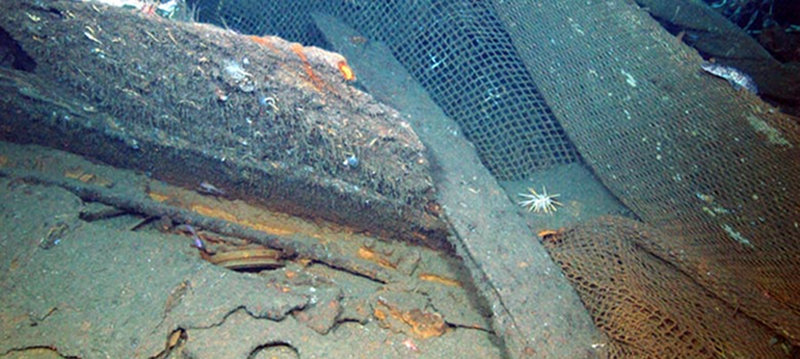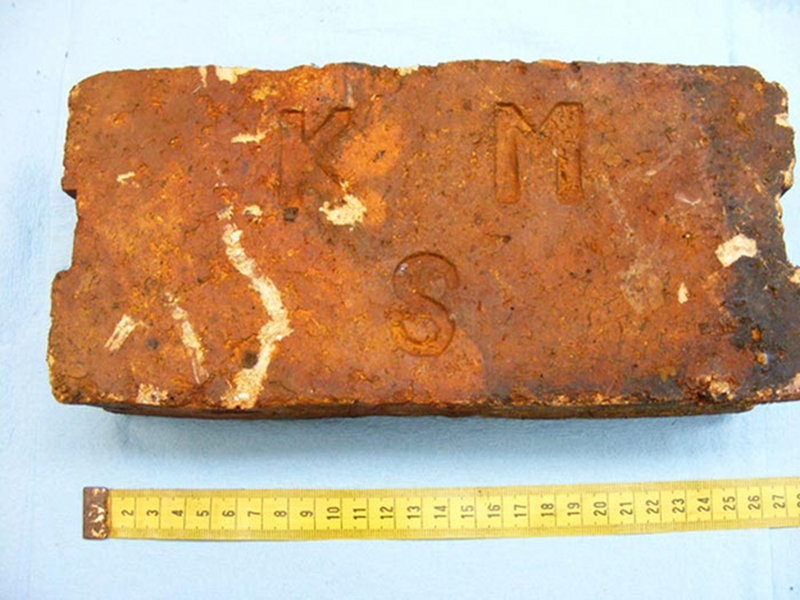
Rod Mather, Professor of History and Underwater Archaeology - University of Rhode Island

Fishing gear damage to one of the destroyers from the “Billy Mitchell Fleet.” Image courtesy of Deepwater Canyons 2013 - Pathways to the Abyss, NOAA-OER/BOEM/USGS Download image (jpg, 102 KB).
The mid-Atlantic outer continental shelf (OCS) intersects with some of the most historically significant waters in the United States and the historical and archaeological importance of the region is substantial. The area has a long and rich history connected to exploration, warfare, commerce, fishing, and recreation. It encompasses the historic approaches to Chesapeake Bay and Delaware Bay and, by extension, key mid-Atlantic ports such as Norfolk, Baltimore, Wilmington, and Philadelphia. Centuries of intense maritime use have left a rich, although poorly understood, repository of cultural material on the ocean floor.
The region also represents an important area for paleo-archaeological investigations. Around 15,000-20,000 years ago, when sea level was approximately 100 meters lower than it is today, Pleistocene megafauna and early human populations (Paleoindians) likely occupied the region.

Ballast brick from one of the destroyers from the “Billy Mitchell Fleet.” Image courtesy of Deepwater Canyons 2013 - Pathways to the Abyss, NOAA-OER/BOEM/USGS Download image (jpg, 115 KB).
The Mid-Atlantic Deepwater Canyons project has already achieved some significant archaeological objectives. During a cruise on the NOAA Ship Nancy Foster in 2011, we generated high-resolution maps of Norfolk, Washington, and Baltimore Canyon,s and some of the outer continental shelf in between. As a result of those surveys, we identified 10 potential shipwrecks and multiple features of the submerged landscape that 10,000 years ago might have provided a suitable sites for human habitation.
In 2012, we returned to the area and used the remotely operated vehicle (ROV), the Kraken II from the University of Connecticut, and investigated nine of previously discovered the shipwrecks. Some of those vessels were World War I vintage German warships that were sunk by the U.S. in the early 1920s during a series of experiments designed to test the use of airpower at sea. The warships had been part of a larger collection of German vessels, taken by the U.S. government as reparations at the end the war.
According to the Treaty of Versailles, all German naval vessels taken by the United Sates were to be either scrapped, or sunk irretrievably, by August 9, 1921. At this time, the leading American advocate of airpower and future founder of the United States Air Force was charismatic U.S. Army General Billy Mitchell. Mitchell was determined to convince a reluctant military establishment, including the U.S. Navy, that aircraft would change the face of warfare, particularly warfare at sea.
In 1921, he contrived a series of experiments in which the requisitioned German warships would be anchored on the edge of the continental shelf near Norfolk Canyon and sunk by a series of increasingly powerful bombs dropped from newly developed bi-planes. The bombing raids and subsequent sinkings were highly anticipated and equally controversial. Multiple government officials and dignitaries witnessed the experiments and many believed that, at a minimum, the most powerful and well-protected vessel, the German battleship Ostfriesland, could not be sunk; it was, after all, one of the most expensive and sophisticated fighting machines of its day.
Mitchell, however, succeeded where many thought he would fail and his bombers sunk all of the vessels they were permitted to attack. In addition to the Osfriesland (a veteran of the battle of Jutland from 1916), Mitchell sunk the cruiser Frankfurt, which had participated in all the major naval engagements of the First World War. The other vessels sunk during the experiments were three U-boats, the U-117, U-140, and UB-148, and three destroyers, the G-102, S-132, and V-43.
All of the shipwrecks investigated last year have suffered damage from heavy fishing gear. This represents a significant impact on important historic sites and a heavy financial loss for regional fishermen. On a more positive note, the wrecks still hold significant archaeological information and are serving as important artificial reefs that provide essential habitats for extensive biological communities. A limited number of archaeological samples were raised during last year’s investigation, including a ballast brick from one of the destroyers.
During the 2013 cruise on board the NOAA Ship Ronald Brown, we will investigate new shipwrecks sites and generate high-resolution photomosaics of some wrecks already identified. We will have at our disposal one of the world’s most sophisticated ROVs, the Jason, and are encouraged by our initial assessments of the vehicle's potential to accomplish archaeological objectives. We will also continue to assess damage to the shipwrecks sites and persevere with our search for pre-historic on the OCS.